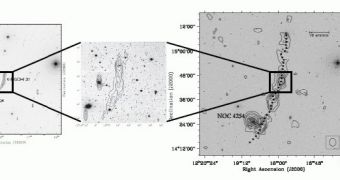An international collaboration of astronomers discovered recently that a massive molecular hydrogen cloud located some 50 million light-years away from our planet is in fact a dark galaxy, a cosmic formation that shines no starlight on its surroundings.
Researchers from the Cardiff University, in the United Kingdom, and the US National Science Foundation's (NSF) Arecibo Observatory, were able to zoom in on the VIRGOHI 21 cloud using the massive observation capabilities of the Arecibo radio dish.
The team says that there is no other plausible way to interpret the results other than to assume that the area is occupied by a dark galaxy. This discovery also goes a long way towards explaining the strangely stretched neighbor surveys found near VIRGOHI 21.
Other investigators disapprove of these conclusions. They argue that the molecular hydrogen cloud is in fact nothing more than the tidal tail of the nearby galaxy NGC 4253, and not a galaxy in itself. These scientists prefer to avoid inserting dark matter into explanations whenever possible.
Additional data of the interesting cosmic structure were collected using the Westerbork Synthesis Radio Telescope (WSRT), in the Netherlands. In these datasets, astronomers noted a rotating motion coming from within VIRGOHI 21, Daily Galaxy reports.
This seems to suggest that the structure itself is moving, a characteristic widely thought to be reserved exclusively to galaxies. Preliminary studies indicate that the dark galaxy may be about 10 billion times more massive than the Sun.
Interestingly enough, telescopes can only detect about 1 percent of this mass. In other words, only a very small percentage of the galaxy's mass is accounted for by the visible, neutral hydrogen accumulations. Therefore, the team believes that the rest of the mass is made of dark matter.
“The dark galaxy theory explains both the observations of VIRGOHI 21 and the mystery of NGC 4254,” Arecibo Observatory investigator Dr. Robert Minchin explains. The reason why NGC 4254 is so baffling is that one of its spiral arms is much larger than the other.
When this happens, the usual culprit is a companion galaxy colliding with its larger counterpart. But no signs of such an event can be observed in this case, unless we consider the possibility that unseen dark matter concentrations are acting on the spiral arm.
“We’re going to be searching for more Dark Galaxies with the new ALFA instrument at Arecibo Observatory. We hope to find many more over the next few years – this is a very exciting time!” Cardiff University astronomer Dr. Jon Davies explains.

 14 DAY TRIAL //
14 DAY TRIAL //